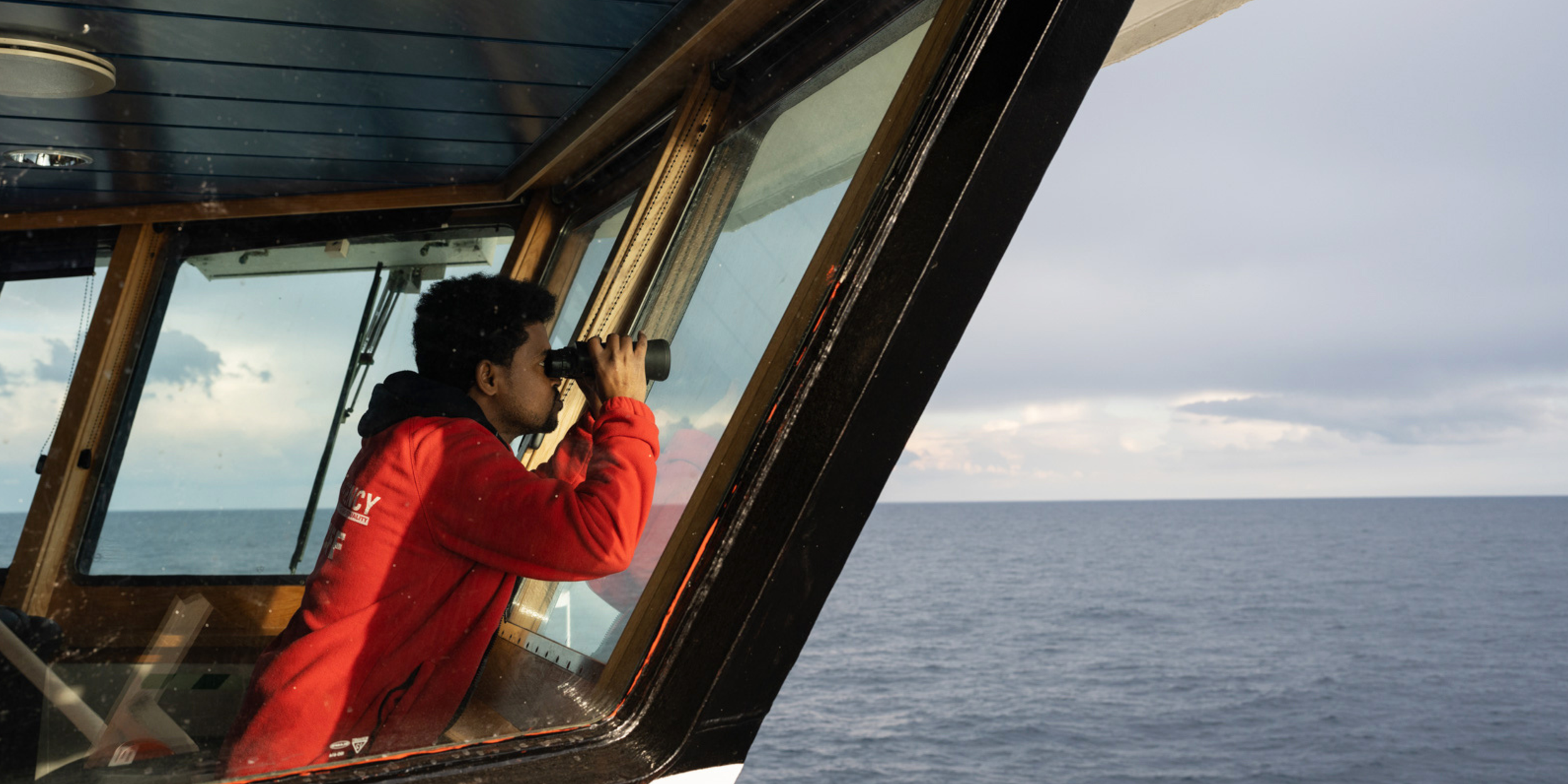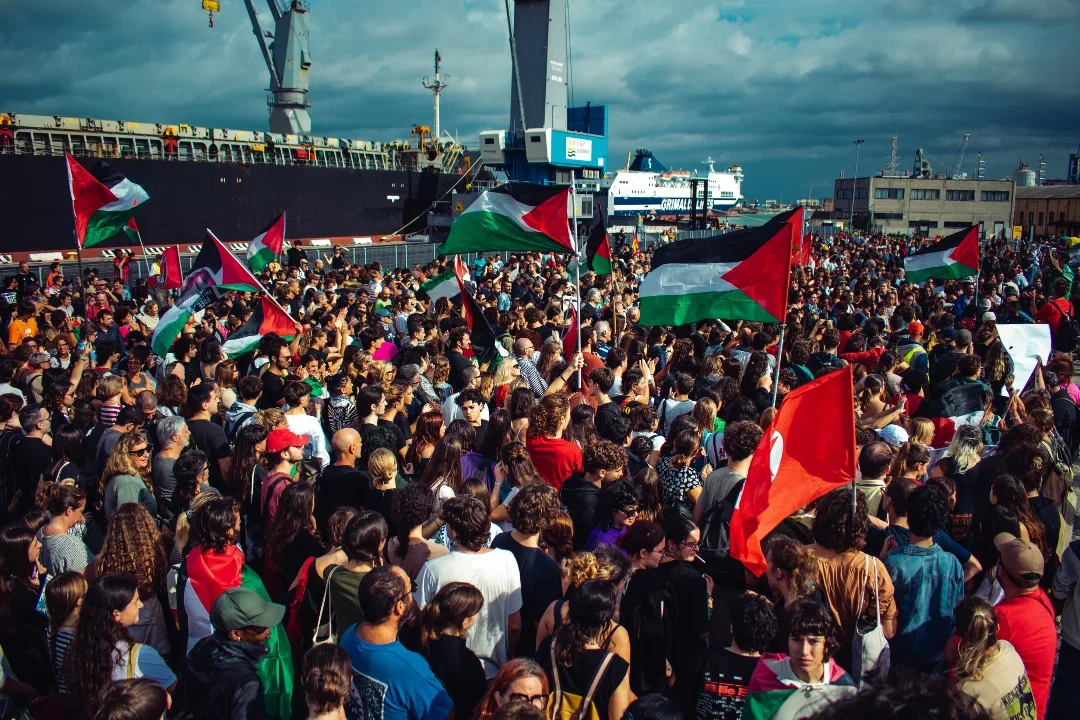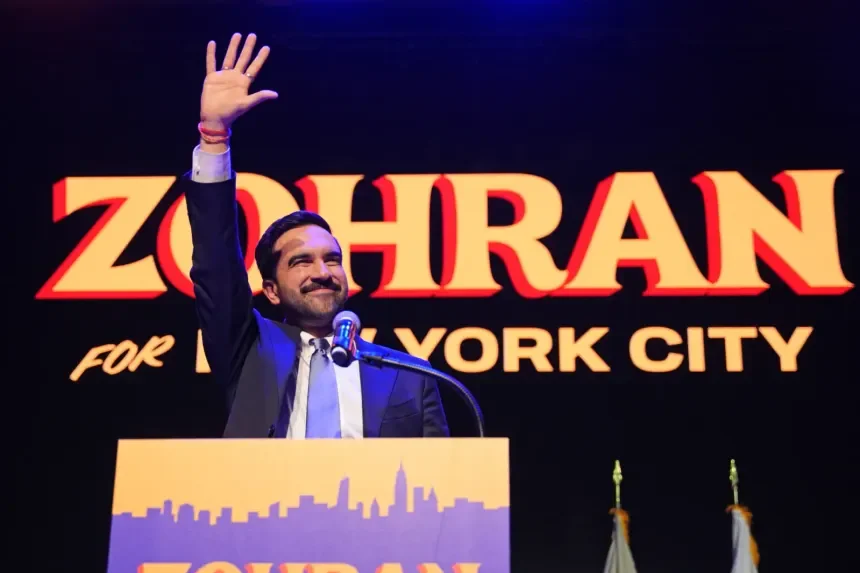Mediterranean: saving lives in the absence of legal pathways
By Veronica Gennari
“Remember that we are not heroes, we are just people helping other people,” says Anabel Montes Mier, the SAR Coordinator (Head of Mission) on board the Life Support, the search and rescue vessel of the NGO Emergency, to her crew. Since 2022, the year the NGO began operating in the Mediterranean to try to save the lives of people in danger at sea, the Life Support has successfully carried out dozens of rescue missions. The Mediterranean is in fact the most dangerous migratory route in the world: between 2014 and 2024, the NGO SOS Méditerranée recorded more than 28,000 victims — a figure that does not take into account the so-called invisible shipwrecks, those of which no trace or memory remains.
The rescuers: a life dedicated to saving lives
When asked “how many search and rescue missions have you taken part in?”, Jonathan Naní La Terra, SAR Team Leader, smiles, looking at the ship: “how many has Emergency carried out?”. The crew joke that he was born on Life Support, together with the sofas and lifejackets. Indeed, Naní La Terra has made search and rescue his life, as shown by the tattoo on his arm: two hands holding each other, surrounded by ropes. “What we in Emergency do is fill a void,” says the SAR Team Leader of the Life Support. NGOs like Emergency operate mainly in SAR zones (search and rescue: maritime geographical areas within which a given State is responsible for coordinating search and rescue operations) in international waters, compensating for the inadequate efforts of coastguards and Frontex, the European Border and Coast Guard Agency. In 2024, non-governmental organisations like Emergency rescued 18% of all people saved in the Mediterranean.
Camille Auvergne, deck leader, is instead on her second mission with Emergency. After ten years as a social worker in various countries, she took a break and began travelling by sea. “At a certain point I simply brought together my two experiences, social and maritime,” says Auvergne, sitting on the deck of the Life Support. “I had always had in mind the idea of working in the Mediterranean, knowing what happens every day on this migratory route. Last year I felt ready and I joined Emergency.”
For Camille Auvergne, her work is a direct consequence of the absence of safe migratory routes. This is a criticism often raised by humanitarian associations and international organisations, which call for the opening of legal migration pathways.
“We must build safe migratory corridors, in a social and humanitarian way, instead of shooting at borders,” says the deck leader. Her idea is echoed by another member of Emergency’s staff, Alessandro Biffi. Already a collaborator with Emergency in Milan, Biffi embarked on the Life Support for two missions. During a lookout shift on deck, Biffi speaks about his experience on board: “I really like the way the people of the Life Support work because they are essentially doing a job hoping never to have to do it again,” he says, alluding to the hope that the unsafe and deadly Mediterranean routes might, one day, come to an end.
The hostility of politics and public opinion
The obligation to provide assistance at sea is enshrined in international law, which is extremely clear on the matter: the captain of a ship is obliged to render aid to anyone in danger. They must therefore proceed swiftly to assist people whose lives are at risk at sea.
When an NGO is near a boat in distress, it is obliged to rescue it — an operation carried out by the SAR Team, and supported by the reception team, made up of medical staff and cultural mediators.
“Once we have rescued a boat, we turn to the competent authorities, who assign us a port in which to disembark,” explains Jonathan Naní La Terra.
Under international law, the port of disembarkation must be the nearest safe port to the location of the rescue.
A “safe port” means a port where survivors are not exposed to risks to their lives, where they can access essential goods and services (food and water, shelter, medical care), and where, for example, they can lodge an asylum application. “The concept of a safe port is very important,” continues the SAR Team Leader, “because it prevents us from disembarking migrant people in unsafe areas such as Libya, where human rights are not protected.” In Libya, there is by now extensive documentation of systematic and ongoing violations of human rights, particularly against those attempting to cross the Mediterranean.
Libya’s role in the Mediterranean is part of what is called the externalisation of borders, a set of practices — in this case by the EU — carried out outside a territory in an attempt to stop migratory flows and prevent migrant people from entering. A practice that Anabel Montes Mier defines as “transferring problems away from Europe”, in this case to Libya, which “instead of rescuing people shipwrecked at sea, takes them back to the very places they are fleeing.” Numerous reports and investigations published in recent years have shown how Europe provides funds to Libya and trains the so-called Libyan coastguard, even though the country is not considered a safe port for migrants. It is also worth noting that the European Union does not have an official agreement with Libya, but some of its member states do — including Italy. “Even though it is Italy that has directly signed this agreement,” says Montes Mier, “Europe is letting this happen, supporting the memorandum.”
“Why does Europe continue to work with Libya even though it is aware of the inhuman practices this state perpetuates against migrant people?”
continues the Head of Mission. “Anyone working in sea rescue asks themselves this question. I think we should ask the decision-makers directly. European Union, this is a question for you: why continue doing this?”
The externalisation of Europe’s borders goes hand in hand with another phenomenon: the obstruction of NGOs’ work, which includes, for instance, the practice of assigning distant ports, justified by the Italian government on grounds of lack of availability and logistical difficulties in southern Italian ports. In 2024, for example, the Life Support was assigned Ravenna three times, Ancona twice, Livorno twice, and once each Civitavecchia, Ortona, Naples, Vibo Valentia, and Catania. “This consolidated practice of the Italian government forced the Life Support to travel on average 630 extra nautical miles per mission, spending over three additional days at sea,” reads Emergency’s 2025 report. Additional days at sea to reach distant ports mean increased costs for Emergency and the use of the ship in a way that prevents it from carrying out further rescues.
It is evident that the Piantedosi Decree is being used by the Italian government to hinder NGOs’ work. “According to the Piantedosi Decree, a ship rescuing a boat in distress must head as quickly as possible to the assigned port,” explains Jonathan Naní La Terra. In practice, therefore, the decree imposes, after an SAR mission, immediate sailing towards the assigned port, even if the number of shipwreck survivors on board is far fewer than the vessel’s reception capacity. Famous, for instance, was the October 2024 mission of the Humanity 1, when the German NGO’s ship rescued a single migrant attempting the crossing alone. Once on board, Rome assigned the port of Empedocle: three days’ sailing for the vessel, which could not remain in the operational area but was forced to leave immediately.
On the right side?
“If there were a barricade, I could never imagine being on the other side,” says Alessandro Biffi, as he scans the horizon with binoculars in search of boats in distress. The issue of immigration and the Central Mediterranean route has been dividing and polarising public opinion for years. It is a division that Camille Auvergne has also sensed among her family, friends, and acquaintances. “Most people around me are very proud and supportive of my work,” she explains, “but many others are uncomfortable and make negative comments. With them I try not to fight, I just ask one question:
‘there are people dying at sea — what do we do?’” explains the deck leader. “Our work is to save lives. End of discussion. People drown and we try to save them.”
Her words take on particular weight as she speaks them after several hours spent searching for bodies spotted in the Libyan SAR zone, which the so-called Libyan coastguard had refused to rescue.
The work of the Life Support is also criticised by part of the political class and public opinion, which criminalise NGOs, accusing them of collusion with traffickers and smugglers. The criminalisation of NGOs, especially by politicians, is a growing phenomenon, as reported by the media monitoring of PICUM — an NGO promoting social justice and respect for the human rights of undocumented migrants in Europe — which in its latest report confirmed a rising trend: in 2024 at least 142 people faced criminal or administrative proceedings for acting in solidarity with migrants in the EU. Several trials have been opened, but none has ever proven collaboration between NGOs and smugglers.
“I think it is very convenient for politicians to say that NGOs are allies of traffickers,” says Biffi. “Because we are here doing a job that they should be doing: the institutions, Europe, and the States that make it up — but are not.”
Alessandro reiterates the idea already expressed by the Head of Mission earlier: “we are not heroes, we are just here to ensure that people arriving from elsewhere have the chance to have rights.” Then he adds: “You know, I really like the word right in English. Because right does not only mean a right but also just, correct. I think it is right that everyone has the same rights, and what we are doing is right.”







